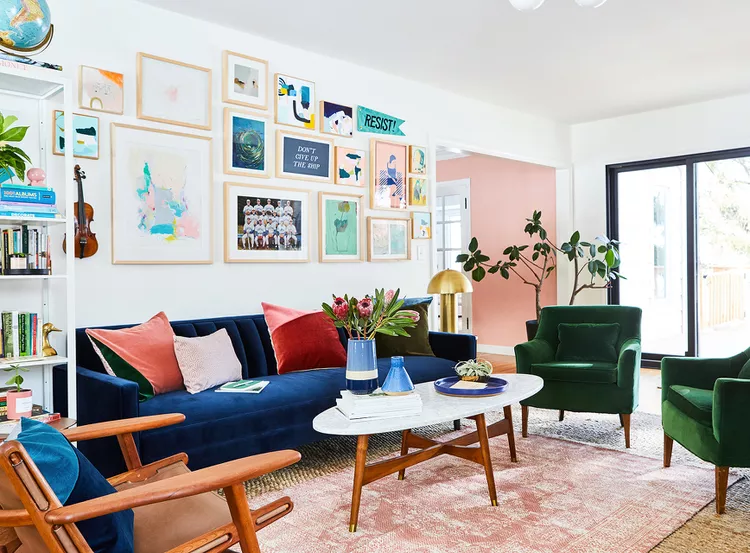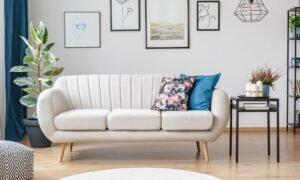Last updated on May 8th, 2024 at 03:06 am
The configuration of your living room’s furniture is crucial to creating a comfortable and inviting space when it comes to interior design.
Whether you are entertaining guests or spending time with your family, a well-organized living room can improve the space’s ambiance and functionality.
In this article, we will delve into the art of arranging living room furniture, offering practical advice, innovative ideas, and expert insights to help you maximize your living space.
Therefore, let’s delve in and discover how to arrange living room furniture so that it transforms your space into a haven of comfort and elegance.
Set up a Living Room Furniture
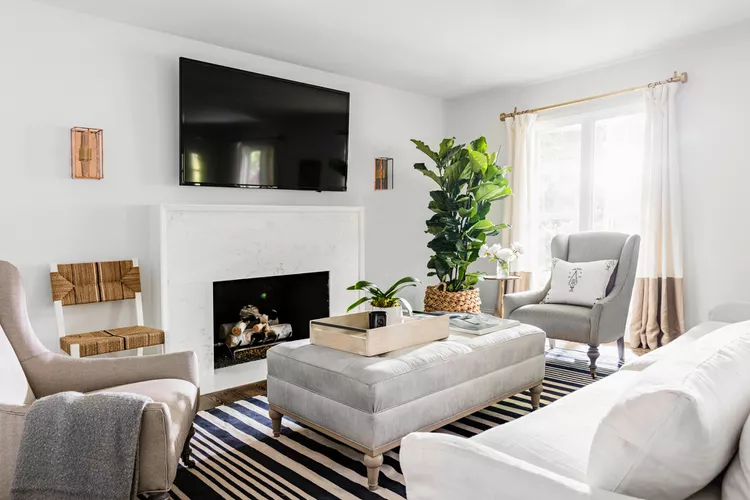
Photo Credit: bhg
The arrangement of living room furniture requires planning and deliberation. You can achieve a well-balanced and visually appealing arrangement that complements your personal style and enhances the functionality of your living room by following these simple steps.
Assess Your Living Room Layout
Before you begin arranging your living room’s furniture, take a moment to assess its layout. Consider the room’s dimensions, shape, architectural features, windows, doors, and focal points when designing a space.
Understanding the layout will allow you to make informed decisions regarding the positioning of furniture.
- Determine the length, width, and height of your living room. This will help you determine the size of furniture that will accommodate the room comfortably.
- Identify any architectural features, such as fireplaces or built-in shelving, that may affect the placement of furniture.
- Note the location of windows and entrances, as well as any obstacles or traffic patterns.
Define the Functionality of Your Space
To effectively arrange your living room furniture, you must determine the space’s primary functions. Are you asking:
- Will the space be utilized predominantly for entertaining guests or for family gatherings?
- Do you intend to include a media center or build a reading nook?
- Will the living room serve multiple functions, such as a home office or a children’s play area?
- By grasping the intended function of your living room, you can make informed decisions regarding the placement and selection of furniture.
Create a Focal Point
Every well-designed living room has a focal point that attracts the eye and grounds the space. Fireplaces, large windows with picturesque views, or fashionable pieces of furniture are typical focal points.
- If your living room already has a natural focal point, such as a fireplace, arrange the furniture to complement and accentuate it.
- Consider creating a focal point with an eye-catching piece of furniture, such as a statement settee or a striking piece of artwork, if one is not already present.
Choose the Right Furniture Pieces
Choosing the proper pieces of furniture is essential for creating a functional and aesthetically pleasing living room. Remember the following guidelines:
- Consider the magnitude and proportion of your living room furniture in relation to its size. Avoid overcrowding the space and using too small or too large furniture.
- Choose furniture with adaptable styles and neutral hues to ensure the durability and adaptability of your living room’s design.
- Achieve a balance between aesthetics and comfort by selecting furniture that is both inviting and visually appealing.
Establish Clear Traffic Flow (continued)
Arrange the furniture so that distinct pathways are created and people can move freely throughout the space.
Consider the natural flow of movement when arranging furniture. Avoid placing furniture in direct traffic lanes or obstructing access to doors or other essentials.
Leave ample space between pieces of furniture to facilitate easy movement and avoid a congested appearance.
Select the Right Sofa Placement
As the sofa is frequently the focal point of a living room, its positioning is essential to achieving a harmonious furniture layout. Your choice of sofa depends on what suits your style and needs best. If you prefer versatility, sectional sofas can offer flexibility as you can arrange them in different configurations to suit your room layout.
On the other hand, if space is limited in your home and you frequently host guests, convertible Sofa Beds can be a practical option. No matter which sofa you choose, here are some few important considerations to think about:
Arrange Chairs and Accent Seating
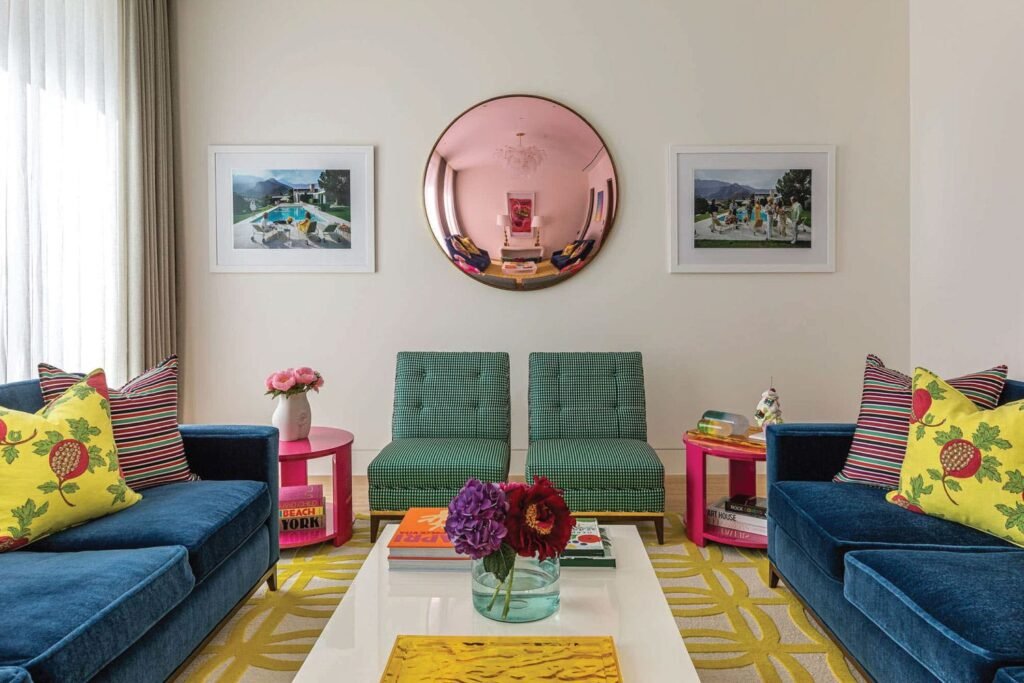
Photo Credit: 1stdibs
In addition to the settee, chairs, and accent seating contribute to the comfort and functionality of the living room as a whole. Follow these guidelines for their placement:
- To promote conversation and social interaction, place chairs facing each other or angled toward the sofa.
- Consider incorporating varied seating options, such as armchairs, recliners, and accent chairs, to add visual interest and accommodate a variety of preferences.
- Create intimate reading spaces and conversation areas by strategically placing accent seating.
Determine Coffee Table Placement
The coffee table in your living room is both functional and decorative. Consider the following placement suggestions:
- To ensure convenience, position the coffee table within easy reach of the seating areas.
- Allow sufficient space for movement between the coffee table and encircling furniture.
- Consider using a compact or multifunctional coffee table to maximize space in a small living room.
Consider TV and Media Center Placement
The placement of a television or media center in your living room requires careful consideration. Here is what you should remember:
- Mount the television on the wall or position it on a stable TV stand, ensuring that everyone in the room has a comfortable viewing height.
- Arrange seating to maximize viewing angles, avoiding glare and reflections from windows and illumination.
- Hide unsightly cables and wires to maintain a clear, organized appearance.
Create areas for conversation
A well-designed living room promotes conversation and interaction. Here are some suggestions for designing inviting conversation areas:
- Place chairs near enough to facilitate easy conversation and ensure that everyone can hear clearly.
- To encourage face-to-face interaction, arrange chairs and couches in a circular or semicircular layout.
- Define conversation areas and visually separate them from the rest of the room with area rugs.
Maximize Storage Solutions
Frequently, living rooms require storage solutions to maintain order and declutter the space. Consider these ideas for storage:
- Include storage-oriented furniture, such as ottomans with concealed compartments or coffee tables with shelves or drawers.
- Utilize bookcases, shelving, and wall units to display decorative items and store books, DVDs, and other items.
- Use baskets, bins, or decorative cases to store and conceal small items in an orderly manner.
Consider Lighting and Ambiance

Photo Credit: ultraleds
Install dimmer switches to have control over the lighting’s intensity, allowing you to create a variety of different moods and ambiance.
Place floor lamps or table lamps strategically to provide task illumination for reading or other activities and to add visual interest to the room.
Consider the room’s natural lighting and utilize window treatments that enable for controllable light levels.
Accessorize Thoughtfully
The addition of accessories to your living room can improve its aesthetic appeal and reflect your personal taste. Remember these guidelines:
- Choose accent pieces, such as decorative pillows, rugs, curtains, and artwork, that coordinate with the color scheme and design of your furniture.
- The arrangement of accessories in odd quantities tends to be more visually appealing.
- Consider the magnitude of your accessories and avoid overcrowding surfaces so that each accessory can stand out.
Consider the Flow with Adjacent Spaces
When arranging the furniture in your living room, it is essential to consider how it interacts with the surrounding areas. Here are some suggestions:
- Ensure that the placement of furniture does not obstruct doors or passageways leading to other rooms.
- Consider color palettes, furniture styles, and flooring options in order to maintain a unified aesthetic between the living room and adjacent rooms.
- Use area rugs or furniture placement to visually define and separate the living room from other spaces, as required.
Experiment with Different Layouts
Don’t be reluctant to experiment with various furniture arrangements in order to find the one that fits your space and lifestyle the best. Here are your options:
- Start by designing your living room’s floor plan and experimenting with various furniture layouts on paper.
- Utilize lightweight furniture sliders or cardboard cutouts to physically test alternative configurations prior to settling on one.
- Consider the adaptability of your furniture and its ability to be easily rearranged to accommodate various needs or occasions.
Maintain Balance and Symmetry
Achieving balance and symmetry in the arrangement of your living room furniture can create an aesthetically appealing and harmonious environment. Observe these tips:
- Arrange furnishings symmetrically around the focal point or center of the room.
- Use matching pairings of furniture, such as end tables or table lamps, to create a sense of equilibrium.
- Ensure that the visual weight of the furniture is evenly distributed throughout the room to avoid an unbalanced or congested appearance.
Consider Traffic Patterns
Understanding the traffic patterns in your living room is crucial to designing a functional and comfortable space. Here is what you ought to do:
- Observe the primary routes that people follow when entering and navigating a room.
- Arrange the furniture so that the flow of traffic is clear and unimpeded, avoiding any potential obstacles or crowded areas.
- Consider the requirements of children and animals, and provide sufficient space for them to move without knocking over objects.
Incorporate Personal Touches
Your living room should reflect your design and personality. Add personal details to make the space feel like home. Here are some thoughts:
- Exhibit photographs, works of art, or mementos with sentimental value.
- Include elements that reflect your interests or activities, such as books, musical instruments, and travel mementos.
- Choose decorative accessories that elicit positive emotions or fond memories in order to create a warm and inviting environment.
Use Mirrors Strategically
- Utilize mirrors to amplify the presence of specific architectural features or room focal points.
- Experiment with various mirror sizes and shapes to add visual interest and variety to your living room’s design.
Consider the Ergonomics
In addition to aesthetics, it is essential to prioritize comfort and ergonomics when arranging your living room furniture. Here are some tips:
- Ensure that the height and profundity of the seating is conducive to proper posture and support.
- Consider the placement of side tables and coffee tables in relation to seating so that drinks, literature, and other items are easily accessible.
- Add cushions or pillows for additional support and comfort.
Make Use of Vertical Space
When placing furniture in your living room, don’t overlook the vertical space available. Here’s how to take advantage of it:
- Displaying books, decorative items, or plants on shelves or bookcases adds storage and visual appeal.
- To create a dynamic and engaging display, suspend artwork or wall décor at varying heights.
- Consider installing floor-to-ceiling drapes to add height and create the illusion of larger windows.
Choose Appropriate Rugs
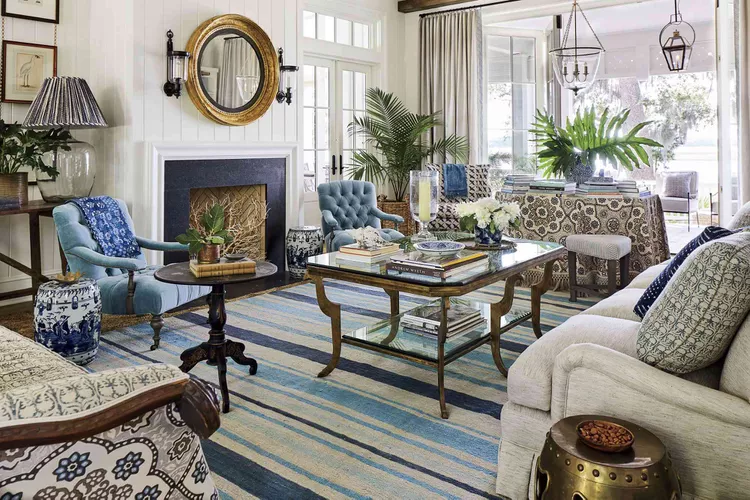
Photo Credit: southern living
Area rugs can bind together the living room’s furniture arrangement. Consider the following factors when choosing rugs:
- Choose rugs that are proportional to your furniture and living room’s dimensions.
- Ensure that the rug is large enough to anchor the seating area by accommodating all furniture legs.
- Choose rugs that complement the color scheme and design of your living room, thereby adding texture and warmth.
Maintain an Open and Inviting Layout
A well-designed living room is characterized by an open and inviting layout. Here are some suggestions for achieving this:
- Avoid obstructing natural pathways and cramming spaces with too much furniture.
- Leave sufficient space between furniture pieces to create an open and airy atmosphere.
- Incorporate symmetry and equilibrium to maintain an aesthetically pleasing and harmonious arrangement.
FAQs (Frequently Asked Questions)
How much space should I leave between furniture in the living room?
It is essential, when arranging your living room furniture, to leave sufficient space for comfortable movement. A general rule of thumb is to allow between 18 and 24 inches of space between pieces of furniture. This allows for simple passage and prevents the appearance of being cramped or crowded.
Should All Furniture In The Living Room Be Against The Walls?
Perhaps not necessarily. Although it may seem logical to position all furniture against the walls, this is not always the most aesthetically pleasing or functional arrangement.
Consider moving some pieces of furniture away from the walls to create intimate conversation areas or to demarcate distinct zones within the room.
Experiment with various configurations to discover the optimal arrangement for your space.
How can I make a small living room feel larger?
1. To maximize space, select furniture with a refined and compact design.
2. Use paint or wallpaper in pale colors to create the illusion of space.
3. Utilize mirrors to reflect light and create the appearance of depth.
4. Choose multifunctional furniture, such as a settee with concealed storage or a coffee table with built-in shelving.
5. De-clutter and organize the area to produce a clean and open environment.
Should I match all the furniture in my living room?
While coordinating furniture sets can create a cohesive and coordinated appearance, it is not necessary for every piece in the living room to be identical.
Combining various designs, hues, and textures can add visual interest and character to a space.
To maintain a sense of harmony, ensure that there is a unifying element, such as a shared color scheme or a consistent design theme.
How do I choose the right-sized furniture for my living room?
When choosing living room furniture, it is essential to consider the room’s dimensions. Follow these instructions:
1. Determine the utmost size of furniture that will fit comfortably in your living room by taking measurements.
2. Allow sufficient space for movement around and through the furniture.
3. Consider the furniture’s dimensions and proportions in relation to the room. 4. Large furniture can overpower a small room, whereas small furniture can leave a large room feeling vacant.
5. Utilize floor plans or online room design tools to visualize the furniture in the room to ensure a suitable fit.
How can I incorporate storage solutions into my living room furniture?
Storage is essential for maintaining an organized and uncluttered living room. Here are some suggestions for integrating storage into your furniture:
1. Choose sofas and ottomans with concealed stowage compartments to conceal blankets, pillows, and other items.
2. To store electronics, DVDs, and gaming accessories, choose entertainment centers or media consoles with shelves or cabinets.
3. Consider utilizing bookshelves or wall units to display decorative items while storing books, periodicals, and collectibles.
4. Utilize baskets or decorative boxes on shelves or beneath coffee tables to elegantly conceal smaller items.
Bottom Line
It is a thrilling opportunity to create a space that reflects your style, maximizes comfort, and encourages social interaction when you arrange your living room furniture.
By taking into account the room’s layout, flow, and functionality, you can arrange the furniture in a way that creates a harmonious and inviting environment.
Remember to prioritize comfort, take advantage of vertical space, and add personal details to make the room your own.
You can transform your living room into a cozy, functional space where memories are made through meticulous planning and a touch of imagination.
